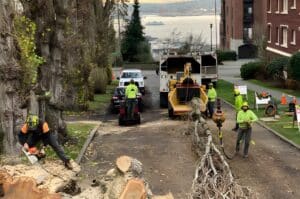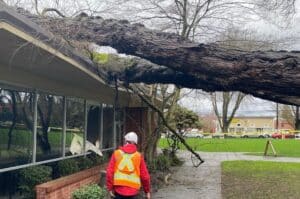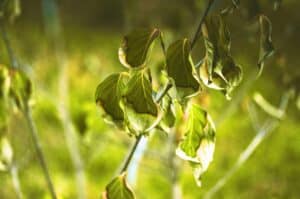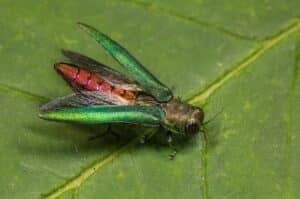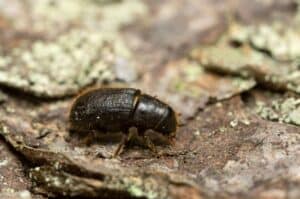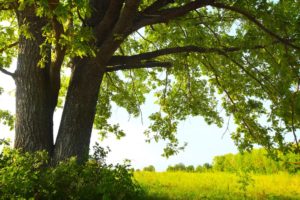Is Your Tree Sick? 10 Signs and Symptoms to Look For
These ten symptoms of a sick tree can mean that your Seattle tree is unhealthy and needs an arborist inspection and treatment for insect infestation or disease.
It’s not always easy to recognize the symptoms of a sick tree. From pests and diseases to nutrient deficiencies and storm damage, there are numerous reasons why a tree may not look its best. The key is recognizing the signs that indicate a tree health problem rather than just cosmetic or temporary issues.
In this article, we’ll explore some common symptoms of unhealthy Seattle trees. If you notice these signs in any of your trees, it’s probably time to have a Certified Arborist inspect the tree, identify the cause of the symptoms, and recommend any necessary treatment options.
10 Signs Your Tree May Be Sick
1. Wilting Leaves
Are your tree’s leaves drooping and curling? Do they appear small and withered? Wilting leaves can happen for different reasons, and the condition is often attributed to the following:
- Underwatering – Your trees need a drink!
- Overwatering – Your tree’s roots are starved of oxygen! Learn how to prevent overwatering.
- Heat Stress – Similar to underwatering, your trees need water. Due to high temperatures, your trees are losing more water through transpiration than they are able to absorb from the soil, even if they’re watered regularly.
2. Yellow Leaves During the Growing Season
Yellow leaves in the summertime can be a sign your tree is unhealthy. But before you panic, make sure the leaves aren’t supposed to be yellow. While many trees’ foliage turns various golden hues in the fall, some trees found in the Seattle area, such as the Pacific madrone, display golden yellow leaves in the summertime.
However, if your tree’s leaves are yellow when they shouldn’t be, it could be due to a number of factors. Common reasons for yellowing leaves include:
- Compacted Soil – The roots can’t grow and absorb oxygen.
- Improper Watering – Too much or too little water can cause leaves to turn yellow.
- Nutrient Deficiencies – The tree is malnourished. See our guide to fertilization for tree health.
3. Brown Leaves
As with yellow leaves, sometimes it’s normal for leaves to turn brown. As they prepare to drop in autumn, many deciduous trees’ leaves turn brown. However, brown leaves during the growing season can indicate health issue, particularly if the leaves are dried up or crispy around the edges. Unseasonal browning in leaves may be the result of:
- Sap-sucking pests such as aphids and scale insects
- Diseases such as verticillium wilt or anthracnose
- Underwatering
4. Leaf Spots
Leaf spots have a variety of causes and can appear in many colors, including yellow, white, brown, black, and red. Leaf spot conditions developing on Washington trees and shrubs are most often the result of:
- Fungi species, including Gloeosporium arctostaphyli and Mycosphaerella pyrolae
- Bacteria of the Pseudomonas and Xanthomonas genera
- Nematodes of the Aphelenchoides and Litylenchus genera
Nematodes are tiny invertebrate pests that attack plants from the soil, while the fungi and bacteria that cause leaf spot conditions have a further reach. In addition to spreading from plant to plant through rainfall, fungal spores, and bacteria can travel long distances on air currents.
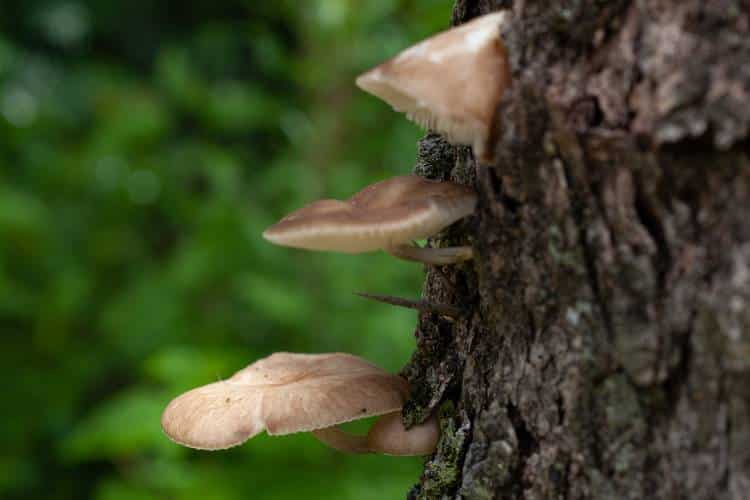
5. Fungi
While several fungal diseases cause visible symptoms in trees, sometimes the fungus itself is the symptom. Look for these fungal symptoms that can be a sign of root rot, a condition often brought on by overwatering or poor drainage.
- Mushrooms growing at the base of your tree
- Shelf-like mushrooms called conches extending from the trunk of your tree
- A musty smell coming from your tree
- Oozing from your tree (not to be confused with sap!)
Sometimes, what appears to be fungal growth on trees is an entirely different organism called lichen. Lichens have a unique symbiotic relationship with trees called commensalism. This means the lichen receives a benefit from the tree (a place to grow), while the tree is unaffected. The lichens on your tree are not causing leaf spot or any other health condition and do not need to be removed.
6. Holes in the Leaves
Assuming the holes in your leaves aren’t the result of a hailstorm or some other physical cause, leaf holes can indicate several issues that could be making your tree sick. Holes in your leaves could be caused by the following:
- Chewing insects and other invertebrates such as caterpillars, slugs, and snails
- Sucking insects such as aphids and mites
- Diseases such as anthracnose, Cercospora, and Coryneum blight, also known as “shothole disease”
7. Premature Leaf Drop
Deciduous trees are known for dropping their leaves in the fall, but if your trees drop their leaves (or in the case of conifers, needles) early, there’s more than likely a serious tree health issue. Premature leaf drop can occur due to a multitude of factors, including:
- Overwatering
- Underwatering
- Root stress
- Pest pressures
- Physical factors such as snowfall, rainfall, or high winds
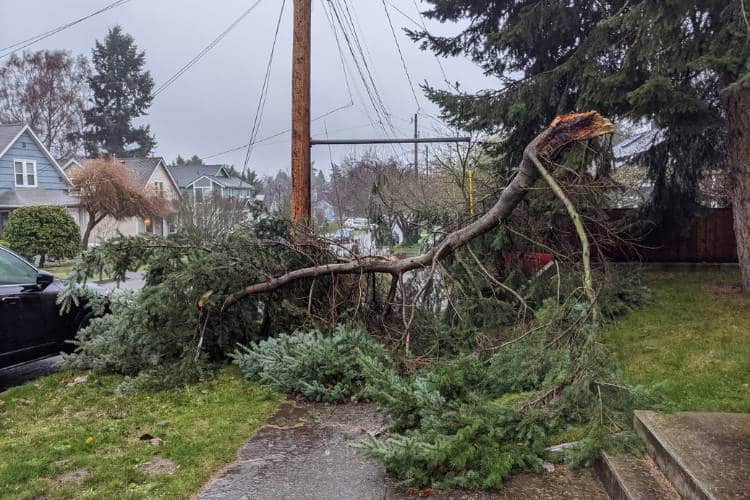
8. Sudden Branch Drop Syndrome
Sudden branch drop syndrome, also called sudden limb failure, occurs on seemingly healthy trees, most often in the summer. While no definitive cause has been connected to the condition, it is believed to be brought on by the following:
- Drought
- High humidity
- Tissue shrinkage and cracking
- Poor pruning
- Bacterial infection
Since the causes of sudden branch drop syndrome are unknown, and the condition could threaten property and people, your large trees should be assessed to identify any branches and limbs at risk of falling.
9. Leaning
A leaning tree is not always an indication that your tree is unhealthy. Trees can lean for various reasons, including high winds, weakness due to shallow or exposed root systems, erosion, or heaving due to soil saturation. If a leaning tree isn’t at risk of damaging property and isn’t a hazard to people, it can generally be left alone.
However, leaning trees can be an indication of a sick tree in some cases. If you’re concerned about your leaning tree, look for the following signs of potential illness:
- Sudden leaning
- Mushroom growth at the base of the tree
- Fungal growth of the tree trunk
- An unpleasant, musty smell and oozing
These are all symptoms associated with root rot. Another thing you can do if you notice these symptoms is to use a small shovel to excavate around the base of the tree. If you uncover roots that aren’t white and firm but are brown, black, and mushy, your tree may be suffering from the potentially fatal root rot.
10. Not Leafing Out
If you’re expecting a lush, full canopy to develop in the spring, then a lack of healthy foliage can be concerning. A tree not leafing out the way it should in the spring usually indicates a serious problem with your tree’s health.
Assuming the tree isn’t dead or just a late leafer, a thin, sparse, unhealthy canopy can be due to several reasons:
- Underwatering
- Overwatering
- Drought
- Pest infestation
- Fungal, bacterial, or viral diseases
- Inadequate sunlight due to overcrowding or shade from a larger tree
- Damaged roots
Worried That Your Tree May Be Unhealthy?
If you’d like help determining if your tree is sick, give us a call! Seattle Tree Care’s certified arborists will evaluate your tree and surrounding landscape thoroughly to diagnose the issue and recommend the best course of action. For example, we consider soil conditions, common pest issues at that time of year, potential diseases known to affect trees in Seattle, cultural factors, surrounding plants, your irrigation system, and anything else about your tree and its surroundings that could affect its overall health.
If your tree is unhealthy and would benefit from a robust plant healthcare regimen, we can recommend an effective solution that works for you and your tree.
Call us today at 206-789-0534 to speak with one of our friendly staff members or fill out our convenient online form, and we’ll get back to you ASAP – usually within 24 hours!
SEE MORE ARTICLES FROM OUR b(LOG)
We've got you covered with tips, resources, updates, how-to's, and other helpful information about trees and landscapes in Seattle, Puget Sound, and King County, WA. Join the thousands of smart local residents who get the monthly newsletter from Seattle Tree Care for helpful information you won't want to miss!
There's no spam - we promise! We are committed to keeping your e-mail address confidential. We do not sell, rent, or lease our contact data or lists to third parties.

